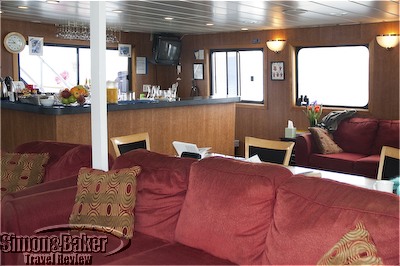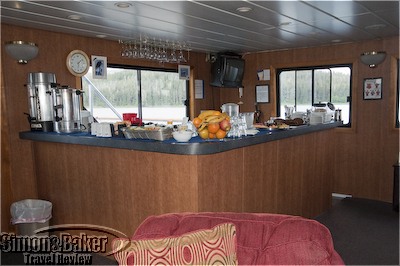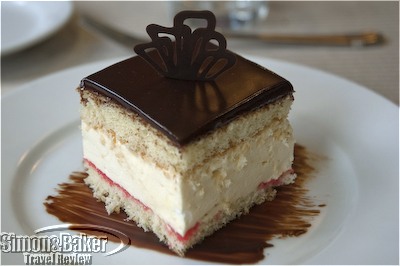
We had left the sleepy fishing port of Petersburg on the evening tide. Soon the Island Spirit was advancing at a leisurely 10 knots per hour (that’s 11.5 mile or 18.5 kilometer for the landlubbers among us) past channel markers draped with sea lions, up Frederick Sound toward our anchorage for the night. Before long, all signs of human habitation faded away, cellular phone signal included. I was standing in the bow viewing area with several of the 15 guests that would be my traveling companions for the next nine days. All of us were bundled against the crisp evening breeze, watching in awed silence the pristine Alaska immensity unfold around us. Distant snowy peaks shone brightly in the evening sun. Puffy clouds were turning gentle shades of pink. The call of gulls and bald eagles could be heard over the discrete purr of the ship’s engines. By the time the crew cast the anchor in Portage Bay two short hours later, I was nearing a state of blissed contentment that remained with me for the remainder of the voyage.
The itinerary was loosely scheduled so that it could be adapted for changing weather conditions and wildlife viewing opportunities. We stopped for whales, orcas or porpoises. We slowed down for seals lounging on drifting ice floes, and accelerated when blankets of clouds rolled down the mountainsides, narrowing the horizon to the nearest shores. It was a time when most passengers retreated to the cozy glassed-in lounge and settled with a book in one of the inviting sofas; until the next announcement from the cockpit alerting us of marine life ahead. We’d all lunge for our coats, cameras and binoculars and rush back to the viewing deck. One of the pleasures of this small ship journey was its intimate, casual atmosphere. It was easy to quickly get acquainted with my shipmates, all of us linked by a common desire to get away from commercial cruising routes and conventional city block-sized vessels to explore at leisure some of the most pristine wilderness in North America.
With electronic communications unavailable for days on end, time became measured only by the breathtaking vistas and exciting wildlife sightings encountered along the way. And with its comfortable accommodations, warm and knowledgeable crew and laidback ambiance, the Island Spirit treated me to one of my most relaxing vacations ever.
Children Teenagers could be accommodated by prior arrangement on a case-by-case basis.
Crew Captain Jeff Behrens
Duration Nine days
Established Captain Behrens acquired the vessel in 1994 and refitted it as a passenger ship for day excursions in the San Juan Islands area of Washington state. After three years of planning and extensive rebuilding to further transform it into a cruise ship, the Island Spirit began operations in Southern Alaska’s Inside Passage in 2008.
Handicapped Access There was a wheelchair on board. Motion impaired guests could be accommodated by prior arrangements on a case-by-case basis.
Internet Connectivity There was no Internet connectivity on the ship, other than while at anchorage in Juneau.
Location The itinerary explored remote areas of the Alexander Archipelago (commonly known as Inside Passage) of southern Alaska, in the North West of the United States.
Number Of Employees In addition to Captain Behrens, the Island Spirit had a crew of eight, including Andy Peters, first mate, and Marie Wagner, a naturalist.
Owned And Managed Fantasy Cruises was a private company owned and managed by its founder Captain Jeff Behrens.
Power The ship had round the clock electricity throughout the guest and public areas. During the night-time hours, electricity was supplied by batteries charged from excess power generated during the daytime, to ensure ultra-quite evenings. There were two convenient outlets in my room that could be used to charge my camera, phone and computer batteries.
Size And Main Features Of Vessel The Island Spirit had an overall length of 128 feet (39 meters). Its 25.6 foot (7.8 meter) beam and 7 foot (2.1 meter) draft made it ideally suited to access narrow passages. Its maximum speed was 17 knots (20 miles or 32 kilometers) per hour. It had 17 cabins that could accommodate up to 32 passengers.
Transportation Alaska Airline had daily flights from Petersburg as well as Sitka to Juneau and Anchorage, Alaska and Seattle, Washington. Fantasy Cruises offered transportation to and from the dock to the airport as well as for shore excursions.
When we finally emerged from the canyon, Ford’s Terror was revealed: a large oval cove rimmed with dramatic slopes covered with black pine forests interspersed with tumbling waterfalls. Above the tree line, shimmering snowy peaks reached out to the cloudless cerulean sky. And this dazzling panorama was mirrored in the undulating waters of the cove. A bald eagle soared overhead. This idyllic instant was only the start of a day of unfolding magic. As we were finishing our dinner, first mate Andy informed us that a grizzly bear was enjoying his at the water’s edge. One of the skiffs had been lowered for those who wanted a closer look. We donned our life vests and headed en masse for the skiff. The weather was still radiant the next morning. While kayaks were an option, I chose to board the skiff again for a ride around the cove. In addition to spotting unusual Harlequin sea ducks and bald eagles nesting high in the trees, I was treated to a rare, close range sighting of a black bear sow and her three tiny cubs. All too soon, it was afternoon slack tide time again and we had to head back out through the canyon. Although I surmise that the next night’s anchorage was suitably picturesque, all I recall of it is that it was not Ford’s Terror.
The next morning was gray and misty as we headed up Endicott Arm to Dawes Glacier. Ice floes became increasingly larger as we went along, until the ship slowed to a crawl. I stared slack-jawed at a mile-long wall of jagged ice about 20 stories high. We inched our way forward to a mere 600 feet (200 meters) from the glacier. From there, we could hear the ice crack as large slabs of it tumbled into the sea, sending waves of churning water across the surface thick with icebergs. Time flew while we challenged each other to locate the sound of the cracks and predict the next slide, and crew members passed out cups of hot cocoa to ward off the chill.
We went on for an overnight stop in Juneau, the state capital. The next morning, after a leisurely visit of the small downtown area and the State Museum, we continued on to Chichagof Island, and the tiny community of Tenakee Springs (population 129). Shore excursion here included a nature walk through the old growth Tongass Forest National Park and a stroll down Main Street, a stretch of gravel-topped dirt road lined with small wooden homes. I peered through the windows of Snyder Mercantile, a picturesque general store that has been a mainstay in town for over a century. It was unfortunately closed that day. A few steps later, I stopped by Party Time, the local bakery, for a freshly baked cookie and a chat with the proprietress.
Our final stop prior to reaching Sitka was the tiny settlement of Baranof Warm Springs, just off the Chatham Strait, with a seasonal population of 30. Its main thoroughfare was a boardwalk leading to hot spring pools located right next to a roaring waterfall for a soak with a view. There was also a bathhouse with three private tubs located right on the bay. Sitka, our final destination, was a bustling fishing port with a rich cultural heritage as the home of the native Tlingit people for over 10,000 years as well as the 19th century capital of Russian America.
Common Areas There were three passenger decks. The lower deck held cabins on both sides of a central hallway and an open viewing area in the bow. From this lower deck an interior staircase led to a spacious lounge and bar that occupied the rear two-thirds of the middle deck. The lounge was lined on three sides with large picture windows for optimum viewing ability. The ambiance was invitingly casual, with five overstuffed rolled-arm sofas covered in coral wool and a pair of matching armchairs constituting the main element of the décor. Several straight back beech wood chairs, upholstered in black cloth, provided additional seating around a long rectangular table in the center of the room. A bookcase held an assortment of reference books on the geology, culture and fauna of the area and a small lending library. A large LCD television screen hung from the ceiling above the banister of the staircase leading to the lower deck. The walls were covered with cherry paneling. Flooring was brown tweed carpeting. An L-shaped bar sat at the rear of the room. Next to it, a door led to a large outdoor viewing deck that ran the width of the ship.
The dining room occupied the front third of the middle deck. It featured rows of rectangular tables that could accommodate four guests each. Seating was a mix of banquettes fitted against the walls and beech wood straight back chairs with black upholstery. The partition separating the dining room from the cockpit at the front of the ship held a serving bar with a dumb butler that brought food up from the galley.
The front half of the top deck was a sheltered observatory with a canvas roof and a semi-circular Plexiglas outer partition. The rear half provided open-air storage for the kayaks and the inflatable zodiac-type excursion boats.
Specialty Small ship wilderness cruise
Meals, soft drinks and alcoholic beverages were complimentary, as were all activities and guided tours on water and shore, transportation to and from the ship and the use of kayaks.
Land and sea mammals I sighted included: black bear, brown bear (also known as grizzly bear), fisher, marten, mink, river otter, sea otter, harbor seal, spotted seal, Steller sea lion, humpback whale, orca whale (a.k.a. killer whale), Dall’s porpoise and harbor porpoise.
Birds included: bald eagle, golden eagle, harlequin duck, marble merlette, arctic turn, herring gull, kittiwake gull and mew gull.
Tours-Excursions While in Juneau, I especially enjoyed my visit of the State Museum. Although small, it had a comprehensive and well-displayed collection of artifacts showcasing the historical traditions of Alaska’s distinct native cultures, including Inupiaq, Yup’ik, Athabascan, Aleut and Autiiq.
In Sitka, Saint Michael’s Russian Orthodox Cathedral, inaugurated in 1848 as the seat of the Russian Orthodox Church of North America, held a rich collection of 18th and 19th century religious icons and other religious artifacts. The Sitka National Historical Park offered pleasant walks through its old growth forest interspersed with historic totem poles. Its visitor center included an additional collection of totem poles as well as interesting museum exhibits depicting the traditions of the local native Tlingit people.
Date Of Voyage June 2011
Reviewers Article and photographs by Josette King
Service My cabin was serviced daily. Every member of the crew was friendly and attentive.
Would You Take This Voyage Again Yes
Contact Information
- Address:
- Fantasy Cruises
- 1121 Northwest 45
- th
- Street
- Seattle, WA 98107
- Phone:
- +1 206 328 4145
- +1 800 234 3861
- Website:
- Email:

















